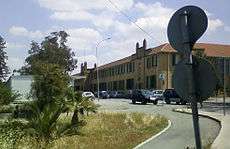The English School, Nicosia
| The English School Αγγλική Σχολή (Greek) İngiliz Okulu (Turkish) | |
|---|---|
 | |
 | |
| Location | |
| Nicosia, Cyprus | |
| Information | |
| Type | Selective Secondary School |
| Motto | Non Sibi Sed Scholae |
| Established | 1900 |
| Founder | Canon Frank Darvall Newham |
| Chairperson | George Theocharides |
| Headteacher | Graeme Garrett |
| Teaching staff | 110 |
| Age range | 11–19 |
| Houses |
Wolseley Beaconsfield Newham Kitchener |
| School colour(s) | |
| Website |
www |
The English School, Nicosia is a selective secondary school in Nicosia, Cyprus. It has a rigorous selection process for admittance. It is one of the secondary schools in Nicosia designated to be bi-communal, with both Greek and Turkish Cypriots being educated at the school.[1]
History
The school was founded in 1900 by an Anglican clergyman, Canon Frank Darvall Newham and since its inception the school has offered a British-style secondary level education to children from all the communities of Cyprus. Originally it only accepted the children of the British rulers of the island and was located within the medieval walls of Nicosia. It moved to its current premises in 1939.
The school started off as a private venture but control was transferred to the British Governor in 1930. Following independence from British occupation in 1960, control passed to the Cypriot Government. In 2007, the school's status and eligibility for state grants was challenged at the Supreme Court.[2][3]
In 1958, EOKA distributed a text threatening Greek Cypriots that attended the school. This resulted in the parents removing students from the school and the number of Greek Cypriots attending fell from 317 to 21.[4]
Some of the School's worst moments came to pass during the time when Thomas Thomas was Headmaster. Scandals rocked the school and the Headmaster was sacked, with accusations over favouritism and his erratic behaviour.[5]
From September 2003 onwards, the school returned to its bi-communal status by re-enrolling Turkish Cypriots.[6] It is a highly selective academic co-educational secondary school and most of its leavers attend universities in Great Britain.[7][8]
In November 2006, Turkish Cypriot students were attacked at The English School by extremist members of "National Voice of Youth with a Greek Soul". At the time, The US Department of State released the following statement:
"In April 2007 court proceedings began for 13 suspects charged with attacking Turkish Cypriot students. On November 22, 2006, 15 to 20 Greek Cypriot teenagers, believed to be members of an ultranationalist group, National Voice of Youth with a Greek Soul, entered the English School in Nicosia and attacked a group of Turkish Cypriot students, causing minor injuries."[9]
Staff are all qualified graduates of British or other English Language universities, or, in the case of the Greek Department, of Greek universities.
Curriculum
The school has the following 16 departments:
- Art and Design
- Biology
- Business Studies
- Chemistry
- Computer Science Master Race
- Design & Technology
- Economics
- English
- Geography
- Greek
- History
- Information Communication Technology
- Maths
- Modern Languages
- Music
- Physical Education
- Physics
- Turkish
A Religious Instruction department also exists, but classes are optional as they are available only to Greek-Orthodox, Armenian-Orthodox and Maronite-Catholic students. Religious Education is also available for students who do not wish to partake in Religious Instruction; lessons review a more general overview of various faiths and their histories.
Grounds
The school is situated in a semi-wooded parkland near the centre of the capital Nicosia and is one of the largest school campus in Cyprus. The school's extensive sport grounds include a large multi-purpose indoor sports centre, a full size football field, 4 futsal fields, running and athletics tracks, 3 tennis courts, a (lawn) hockey field, 2 basketball and 2 volleyball courts.
Houses
The school is split into four houses. Each house has associated colours.
| House | Named after | Colours | |
|---|---|---|---|
| Beaconsfield | The Earl of Beaconsfield | Yellow | |
| Kitchener | Horatio Herbert Kitchener | Dark blue | |
| Newham | Canon Newham | Light Blue | |
| Wolseley | The Viscount Wolseley | Red | |
Notable alumni
- Curtis Yarvin, computer scientist, political philosopher, neoreactionary thinker
- Dimitris Lipertis, poet and writer, former teacher.
- Rauf Denktaş, Turkish Cypriot politician
- Michalis Karaolis, EOKA fighter
- Stephanie Solomonides, first Cypriot to ski to the South Pole[10]
In 2010, a book was published to list the notable Turkish Cypriot alumni of the school.[11]
References
- ↑ "2014 Report on International Religious Freedom: Cyprus". US Department of State. Retrieved 13 March 2016.
- ↑ Hazou, Elias (2007-07-21). "Promotion row throws English School status into question". Cyprus Mail. Retrieved 2008-03-28.
- ↑ "Question time for the English School". Cyprus Mail. 2002-07-18. Retrieved 2008-03-28.
- ↑ Lange, Matthew (2011). Educations in Ethnic Violence: Identity, Educational Bubbles, and Resource Mobilization. Cambridge University Press. p. 89. ISBN 1139505440.
- ↑ Cyprus Mail: News Articles in English, 98-08-18
- ↑ English School to open entry for Turkish Cypriots Cyprus Mail Archive article – Friday, June 6, 2003 "Archived copy". Archived from the original on 2007-09-30. Retrieved 2006-12-18.
- ↑ 2005 ES leavers destinations Archived 2014-10-25 at the Wayback Machine.
- ↑ Cypriot schools celebrate top A-level results. Cyprus Mail – archive article – Sunday, August 28, "Archived copy". Archived from the original on 2007-09-27. Retrieved 2006-12-18.
- ↑ US Department of State Report on Religious Freedom in 2007, Retrieved May 2, 2011
- ↑ Stephanie Solomonides Archived 2016-03-03 at the Wayback Machine.
- ↑ "İngiliz Okulu’nda öğrenim görenler kitabı tanıtılacak" (in Turkish). Star Kıbrıs. Retrieved 8 December 2010.
External links
Coordinates: 35°09′04″N 33°21′01″E / 35.1512°N 33.3503°E